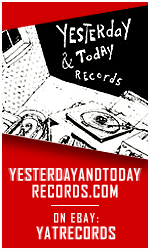

True Womanhood continues our very last TVD Takeover Week ever:
This past weekend, J Robbins, still exhausted from the Government Issue reunion the previous night, was nice enough to talk to us about his studio and recording philosophy.
J’s accomplishments as a musician in bands like Government Issue, Jawbox, Burning Airlines, Channels and now The Office of Future Plans are well documented but what interested us on this occasion was his “day job.” It’d be inaccurate to call it a 9 to 5 considering his work often carries on late into the night.
We are, of course, referring to the work J does at the Magpie Cage, the Baltimore studio where he has recorded the likes of Clutch, Colosseum, Ponytail, Yeasayer, and of course, True Womanhood. J recently made the bold move of re-embracing analog recording after several years of being a digital studio. As novice reel to reel recording engineers ourselves, we were excited at the chance to hear J’s thoughts and to share them with you for our next feature.
 Recording to tape is a lot like listening to vinyl. In both cases you are taking extra effort and expense to use an outdated technology. MP3s and Protools have revolutionized both the recording and consumption of music, yet, there still remains a devoted “analog” following. J puts it very simply, “There’s more music in the music.”
Recording to tape is a lot like listening to vinyl. In both cases you are taking extra effort and expense to use an outdated technology. MP3s and Protools have revolutionized both the recording and consumption of music, yet, there still remains a devoted “analog” following. J puts it very simply, “There’s more music in the music.” The experience of recording in Protools is a lot like using Photoshop. Your sounds appear on the screen and all edits effect an instantaneous visual change. As J puts it, “the Protools user interface dictates the musical aesthetics of popular music to an absurd degree, instead of the other way around.” The recording process is now a combination of both listening and watching music.
 But there’s more to the tape versus digital debate than just the recording process. Recording to tape colors the sound in away that digital interfaces cannot simulate. Often the words “warm” and “magical” are thrown around but what’s really happening, as J explained to us, is the tape is compressing the sound, subtly distorting it and bringing out a richer harmonic content. Also, since tape machines are mechanical there are slight variations in playback speed that while nearly imperceptible, lend the music a more natural sound. Such flaws, inherent to analog recordings, do not exist in the digital realm and this digital transparency can sometimes lead musicians on a futile hunt for perfection.
But there’s more to the tape versus digital debate than just the recording process. Recording to tape colors the sound in away that digital interfaces cannot simulate. Often the words “warm” and “magical” are thrown around but what’s really happening, as J explained to us, is the tape is compressing the sound, subtly distorting it and bringing out a richer harmonic content. Also, since tape machines are mechanical there are slight variations in playback speed that while nearly imperceptible, lend the music a more natural sound. Such flaws, inherent to analog recordings, do not exist in the digital realm and this digital transparency can sometimes lead musicians on a futile hunt for perfection. “There is a lot of fear involved in digital recording... fear of imperfection when a lot of what we love about certain classic records are the imperfections” J explained his theory that “records made before you could make everything perfect are more enduring because your brain has to participate more to manage the imperfections and that process is more rewarding.”
 Of course, all this relatively rare, vintage recording equipment doesn’t come cheap. Sixteen track 2” tape machines such as J’s go for between $2000 and $4000 when you can find them in decent condition. Also, at around $200 dollars for a reel of 2” inch tape you’ll have about 30 minutes of recording time... very different from the digital world where cheap memory has made such concerns obsolete. But maintaining an up to date Protools studio is expensive as well. Upgrading to the latest version of Protools including hardware costs around $5000 and that’s not including the necessary purchase of a new computer.
Of course, all this relatively rare, vintage recording equipment doesn’t come cheap. Sixteen track 2” tape machines such as J’s go for between $2000 and $4000 when you can find them in decent condition. Also, at around $200 dollars for a reel of 2” inch tape you’ll have about 30 minutes of recording time... very different from the digital world where cheap memory has made such concerns obsolete. But maintaining an up to date Protools studio is expensive as well. Upgrading to the latest version of Protools including hardware costs around $5000 and that’s not including the necessary purchase of a new computer. J explains, “I could spend the money to stay on the Protools upgrade path, investing more and more every year into a sound that will essentially always sound the same... or I could invest in a tape machine and be slayed every time I record. Why wouldn’t I want to be slayed?”
Check out J’s band, Office of Future Plans on Facebook. You can also follow them on Twitter. Magpie Cage website is here.






















No comments:
Post a Comment